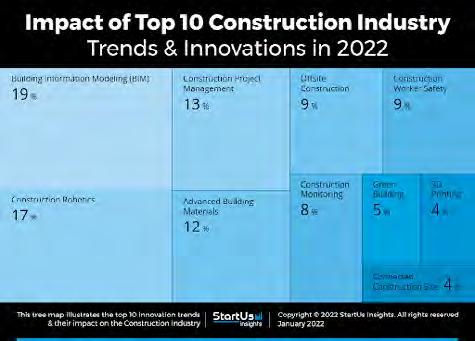5 minute read
The Construction Industrial Revolution and the Rise of the Machines
FEATURE
The Construction Industrial Revolution and the Rise of the Machines—An examination of builders thinking like manufacturers in a world of modularization
by Gregg Schoppman, FMI
The construction industry continues to hear how it lags the rest of the civilized world when it comes to innovation, productivity and efficiency. Studies benchmark the massive gains that manufacturing has experienced while construction languishes at the bottom. Before the pile-on continues, it is important to note that there are never footnotes that provide contextual evidence to support manufacturing gains. Items like automation, technology, controlled environments and even the fact that the same goods are manufactured daily have greatly enhanced manufacturing’s claim of dominance. Furthermore, manufacturing has eliminated one of the greatest variables – humans. Construction projects are still largely dominated by humans doing things that humans do – work, rest, communicate, interact and yes, make mistakes. As a result, construction has continued to evolve and try to replicate many of the attributes that have aided manufacturing. Prefabrication, modularization, automation and even eliminating the human element with autonomous equipment and robotics have all become the zeitgeist. So, what does this mean for the construction company of tomorrow? Do the challenges and problems dissolve once the machines have taken over? Do construction firms that look more like manufacturers have all of the upside with no downside?
The upside has been characterized repeatedly – improved productivity and enhanced safety. The controlled setting provides unbridled control that a jobsite never could. For instance, building a multi-story commercial office building in Florida, in the summer has a host of risks that a manufacturing never had to consider. Extreme heat, high probability of extreme weather, extreme safety
hazards – all of these external factors rear their ugly head even before items such as workforce development even enter the conversation. Modularizing any or all of the elements of this office building sounds like a superior build. However, there are important ramifications that any firm should consider when embarking on this new strategic concept.
Spatial Constraints
Most contractors would argue that jobsites are becoming smaller and smaller. Building in an urban setting is the equivalent of playing a high stakes game of pick-up sticks, hot potato and cup-stacking simultaneously. Now, move that operation into a warehouse. Sounds easy but where will you build that structure or system? Look at the most sophisticated manufacturer and you will come to the realization that it takes real estate. Not simply real estate to build, but also space to store finished items, store inventory, conduct quality control, and lastly mock-up components. A commercial general contractor or a specialty trade contractor that has historically brokered all of its work or used “just in time” inventory practices has not had to deal with the encumbrances of space planning. The jobsite may be small but so was the warehouse that has historically been used on a limited basis.
Shift From a Variable Cost Business to a Fixed Cost Business
Most contractors operate on a fairly low overhead basis, proportionally speaking. In the event of a recession or economic downturn, the cost to cover overhead is much smaller when compared to a fixed cost business like a manufacturer. All of that extra space, fixed equipment, inventory, etc. costs money. While there are productivity gains, those gains are achieved on backlog. With no backlog, there is a sizable cost burden that must be absorbed. No one wants to think of the downside, but these are all economic considerations that manufacturers think about when setting up a plant or operation.
Transportation
An electrical contractor that prefabricates junction boxes or light fixtures complete with whips is one thing. A contractor that builds entire modularized sections of classrooms or laboratories is another logistical hurdle altogether. Obviously, there are plenty of amazing examples of firms that have overcome this challenge. Overcoming it began in preconstruction planning and stemmed from having a logistical sequencing plan that was best of class. However, there are also costs to consider in shipping, staging, and erection that are significantly different than traditional trucking expenses. In the end, has a cost/benefit analysis been done to weigh the modularization cost impacts with the “traditional build” costs?
Training and Workforce Development
Yes, you still have to invest in the people. Training and development is just different with a manufacturing setting. The skills needed to be successful may look similar but there are elements that need to be included in an associate’s development that a traditional builder might not consider. All of the previous elements discussed are great examples –logistics management, workflows, modularization, staging – are all variations on themes that should be covered. While automation and robotics may enhance construction, there is still a need for humans to use these TOOLS effectively. On a side note, in an industry that has so often been plagued with the “dirty job” moniker, does this shift in what the work force will look like, aid firms that continually say “we can’t find good people”?
Safety
One of prefabrication and modularization’s main tenets was the ability to drive safer work. This does not happen by chance – firms most still plan to be safe. However, there is also a risk of complacency. Working in a climate controlled setting feet from the main office can provide an awkward feeling of safety “just happening by osmosis.” Manufacturers have just as many risks as a contractor, but they are different risks. For instance, working on the leading edge of a manufactured component that is 12’ tall is the same 12’ that a craftsperson would see on a jobsite. Fall protection, lanyards, leading edge awareness, etc. are all things that still must be considered. The operative word is complacency.
The industry continues to make massive shifts in how it builds to keep up with the growing demands from clients and customers. Few could argue that these trends are not innovative and progressive. However, the key for best of class firms is to understand all of the factors that go into making drastic strategic pivots.
About the Author
As a principal with FMI, Gregg specializes in the areas of productivity and project management. He also leads FMI’s project management consulting practice. He has completed complex and sophisticated construction projects in several different niches and geographic markets. He has also worked as a construction manager and managed direct labor. FMI is the largest provider of management consulting, investment banking, and research to the engineering and construction industry. FMI works in all segments of the industry providing clients with value-added business solutions. For more information on FMI, please visit www.fminet.com or contact by email at gschoppman@fminet.com.








